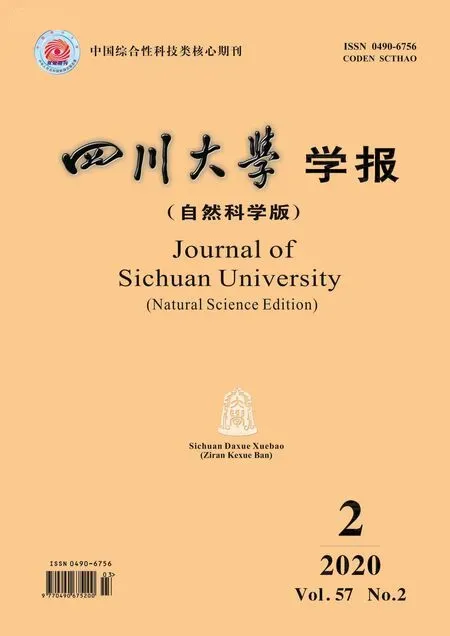一类变时滞模糊神经网络系统解的渐近概周期性
2020-04-01李洪旭
罗 扬, 李洪旭
(四川大学数学学院,成都610064)
1 Introduction
The traditional cellular neural networks (CNNs) proposed by Chua and Yang[1]have been widely developed (see Refs.[1-3] and the references therein). Based on CNNs, Yang[4]introduced the fuzzy cellular neural networks (FCNNs), which added fuzzy logic to the structure of traditional CNNs. The periodicity and almost periodicity of CNNs and FCNNs have been paid great attention in the past decade due to their potential application in classification, associative memory parallel computation and other fields (see,e.g., Refs.[5-10] and the references therein).
There are few works of the almost periodicity for FCNNs with delays. Let us give a brief summary in this line. Huang[11-12]studied the almost periodicity for FCNNs with time-varying delays and multi-proportional delays. Xu and Chen[13]presented some results on the almost periodicity for FCNNs with time-varying delays in leakage terms. Liang, Qian and Liu[14]studied pseudo almost periodic solutions for FCNNs with multi-proportional delays. To the best of our knowledge, there is no result on the asymptotical almost periodicity of the solutions for FCNNs with time-varying delays.
In this paper, we consider the asymptotical almost periodicity and global exponential stability of the following FCNNs systems with time-varying delays:
t≥t0≥0,i∈J={1,2,…,n}
(1)
wherexi(t) is the ith neuron’s state,ai(t) is the ith neuron’s self-inhibition,bij(t) andcij(t) are feedback template and feedforward template,dj(t) is the ith neuron’s input, ∧and ∨ are the fuzzy AND and fuzzy OR operations,αij(t) andβij(t) are the elements of the fuzzy feedback MIN template and fuzzy feedback MAX template,τij≥0 is transmission delay,fj(x) andgj(x) are activation functions,Hij(t) andGij(t) are the elements of the fuzzy feedforward MIN template and fuzzy feedforward MAX template andIi(t) is the time-varying external input of the ith neuron. We present some results on both global exponential stability and asymptotical almost periodicity of the solutions for (1) (Theorem 3.2 and 3.3) and get the structure of the solutions for (1) (Corollary 3.4).
The initial conditions of system (1) are of the form
xi(t)=φi(t),t∈[t0-τi,t0],i∈J
(2)
2 Preliminaries

Definition2.1[15]A setS⊂Ris said to be relatively dense if there existsL>0 such that [a,a+L]∩S≠∅ for alla∈R. A functionu∈BC(R,Rn) is said to be almost periodic onRif for anyε>0 , the setT(u,ε)={τ:‖u(t+τ)-u(t)‖<ε,t∈R} is relatively dense. Denote byAP(Rn) the space of almost periodic functions with supremum norm.

Definition2.3[15]Letφbe defined onR+=[0,+∞) toRn. Then the continuous funcitonφis asymptotically almost periodic (abbr.a.a.p.) if and only if there is an almost periodic funcitonpand a continuous fucntionqdefined onR+with limt→∞‖q(t)‖=0 such thatφ=p+qonR+. The functionpis called the almost periodic part.
Lemma2.4[15](i) Any finite set of functions inAP(Rn) is a uniformly almost periodic set.

Definition2.5[11]A solutiony(t) of system (1) is global exponential stable if there exist two positive constantsμandMsuch that
‖y(t)-x(t)‖≤Me-μt,t≥t0
for any solutionx(t) of system (1).
We will use the following assumptions:
(H1)ai,bij,cij,dj,αij,βij,τij,Hij,Gij,Iiare a.a.p,i,j∈J;

(H3) For eachi∈J,


λi(t)=-ai(t)+

and
Remark1 It is not hard for us to see that the assumptions (H1)~(H3) and Lemma 2.6 guarantee the existence and uniqueness of solution of system (1)-(2). Here we omit the details. Similar result can be found in Ref.[13].
3 Main results
Lemma3.1Assume that (H1)~(H4) hold. Then the solutionu(t) of system (1)-(2) is bounded on [t0,+∞).

Without loss of generality, we assume thatM>0. Then we only need to prove
(3)
whereηis given in (H4). Fort1≥t0, we first prove that there existsδ>0 such that
(4)
IfK(t1)=0, (4) holds sinceK(t) is continuous andM/η>0. So we may assume thatK(t1)>0, and we have two cases.
Case 1. Assume that ‖u(t1)‖
Case 2. Assume that ‖u(t1)‖=K(t1). By (H2), (H4) and Lemma 2.6, for |ui(t)|>0,i∈J,
λi(t1)‖u(t1)‖+M<-ηK(t1)+M.

Letγ=sup{t≥t0:K(t)≤max{K(t0),M/η}}. Ifγ∈R, we haveK(γ)≤max{K(t0),M/η}. Meanwhile, by (4), there existsδ>0 such thatK(t)≤max{K(γ),M/η} fort∈(γ,γ+δ). Therefore,K(t)≤max{K(t0),M/η} fort∈[γ,γ+δ), which contradicts the definition ofγ. Thusγ=+∞, and (3) is true.
Theorem3.2Assume that (H1)~(H4) hold. Then the solutionu(t) of system (1)-(2) is a.a.p. .
ProofBy Lemma 3.1,u(t) is bounded on [t0,+∞). Denote
and
whereρ=c,α,β,H,G,τ,
whereζ=d,Lg,fu,gu,
P={ai,bij,cij,dj,αij,βij,Hij,Gij,Ii:i,j∈J}
and


Pap={ξap:ξ=ξap+ξs∈P},
Ps={ξs:ξ=ξap+ξs∈P}
and
(5)

v(t)=u(t+w)-u(t),ψ(t)=
Letγ>t0, such that
Then
|ξ(t+w)-ξ(t)|≤|ξap(t+w)-ξap(t)|+
(6)
Fort1≥γ, we claim that there existsδ>0 such that
(7)


Noticing that
by (H4) we have
sign(vi(t))v′i(t)≤


Next we prove that
(8)

Now, it follows from (8) that
‖u(t+w)-u(t)‖=‖v(t)‖≤
This implies that


Theorem3.3Assume that (H1)~(H4) hold. Then any solution of system (1) is global exponential stable.
ProofLetu(t),x(t) are two solutions of (1),w(t)=u(t)-x(t),t∈[t0,+∞). It suffices to prove that there exist two positive constantsμandMsuch that
‖w(t)‖≤Me-μ t,t≥t0
(9)

Lett1≥t0withθ(t1)>0. We claim that, for someδ>0,
θ(t)=θ(t1),t∈(t1,t1+δ)
(10)
If eη t1/2‖w(t1)‖<θ(t1), then eη t/2‖w(t)‖<θ(t1) fort∈(t1,t1+δ) with someδ>0 since eη t/2‖w(t)‖ is continuous, and (10) holds. If eη t1/2‖w(t1)‖=θ(t1), for |wi(t1)|>0,i∈J, then
This simply implies (10) holds for someδ>0. It follows from (10) thatθ(t)≤θ(t0) fort≥t0. Then ‖w(t)‖≤θ(t0)e-η t/2for allt≥t0. This follows that (9) holds withM=θ(t0),μ=η/2.
By Theorem 3.2 and 3.3, we have the following corollary immediately.

